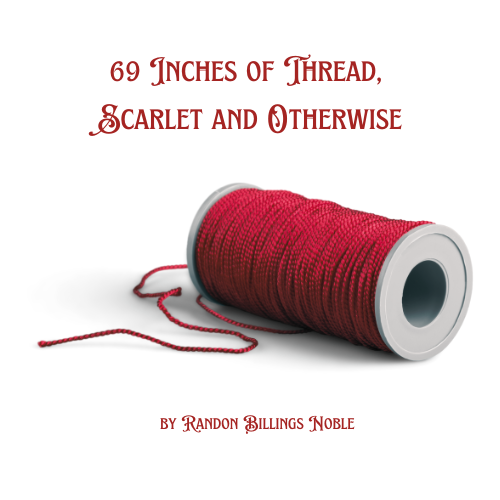FLASHBACK: 69 Inches of Thread, Scarlet and Otherwise
“There’s the scarlet thread of murder running through the colourless skein of life, and our duty is to unravel it, and isolate it, and expose every inch of it.” – Sherlock Holmes, A Study in Scarlet
Scarlet: ORIGIN Middle English (originally denoting any brightly colored cloth)
When I was 15 I bought a bright red dress to wear to my friend’s confirmation.
At the party he had the DJ play “Lady in Red” and asked me to dance.
Everyone looked at us, me hot with power but otherwise cool.
About the same age I started reading the Sherlock Holmes novels.
Scarlet: from late Latin sigillatus ‘decorated with small images’
I had a notebook then, what I might call a commonplace book now, where I wrote song lyrics I liked, and poems, and glued in black-and-white photographs, and drew vines and stars and spirals in the margins.
One of the poems I would recite again and again to myself over the years, when the shine left a romance was Mary Caroline Davies’ “Rust”:
Iron, left in the rain
And fog and dew,
With rust is covered. — Pain
Rusts into beauty too.
I know full well that this is so:
I had a heartbreak long ago.Davies was born in the 1890’s, one hundred years before I found her poem, but just a few years before Arthur Conan Doyle set Sherlock Holmes loose in the world.
When we first encounter Holmes – “meet” feels like too friendly a verb – he is trying to devise a test for human hemoglobin, the iron-containing protein within red blood cells.
With this knowledge Holmes can analyze bloodstains at the scene of a crime.
Scarlet: … from sigillum ‘small image’
Despite my success with the red dress, I did not court attention.
I wanted to be the observer, not the observed.
I liked to keep secrets. Your picture, cut from the church directory, in a locket. Your photograph, stolen from the school darkroom, in my favorite paperback. Some small part of you hidden in some small part of me until I could make it real.
When I was half again as young I read Harriet the Spy and filled my own composition notebooks with observations about my family, my friends, neighbors and strangers.
I thought I would be a spy.
Instead I became an essayist.
Thread: ORIGIN Old English thrǣd (noun), of Germanic origin; related to Dutch draad and German Draht, also to the verb throw.
Sherlock Holmes was only undone once, and by a woman.
I have undone several boys and several men, thrown them over – never casually, but with the same relentless trajectory. And several have thrown me.
But if you’re not going to tie your knot to another, what else is to be done?
Besides, a metaphorical broken heart rarely kills.
Alternate definitions of “murder” range from …
… a very difficult or unpleasant task or experience (when no would not be taken as an answer)
… to punish severely or be very angry with (when you said, “People who love each other don’t treat each other that way”)
… to conclusively defeat (when Irene Adler – “the woman” – escapes from Sherlock Holmes and disappears)
… to spoil by lack of skill or knowledge (when I didn’t know how to eat a tamale and made to bite the husk, when I gouged the brie instead of taking the rind, when I spit the scotch back into the glass, when my salary wasn’t enough, when my not-caring about these things was too much)
And the shame of it – the hot blush of ignorance and innocence, especially when provoked by desire.
What can be told from the stain of blood across the cheek?
And how much should be told?
Must every inch be unraveled and exposed?
Unravel: ORIGIN late Middle English (in the sense ‘entangle, confuse’): probably from Dutch ravelen ‘fray out, tangle.’
A relationship can unravel, a lie, a pose, a mask, a front.
Unraveling causes confusion, but confusion can also cause unraveling.
“There are two kinds of women: those who knit and those who unravel … Once I see the loose thread, I am undone. It’s over before I have even asked myself the question: Do I actually want to destroy this?”– from the essay “The Unravelers” by Stephanie Danier
I have unraveled relationships, lies, poses, masks, fronts.
I have unraveled medieval texts and Renaissance plays, 19th century novels and 21st century essays.
I have knit myself to unravelers and been unraveled myself.
I have been an unraveler of knitters.
Does unraveling always destroy?
Can magic survive scrutiny?
Or is there always a trick, a mirror, a misdirection to be exposed?
Skein: a length of thread or yarn, loosely coiled and knotted.
Skein: a tangled or complicated arrangement, state, or situation.
Skein: a flock of wild geese or swans in flight, typically in a V-shaped formation.
Astonishment: The sound of wild geese flying over me, in my kayak in the middle of the lake, the way they broke the stillness with their loud and throbbing wing beats, the way the sound itself seemed to propel them through the air, the way the dip of my paddle into the water after they left felt so weak and feeble as I returned to shore, returned to you, thinking only of when I, too, would fly away.
But don’t forget: Pain rusts into beauty too.
I am 69 inches long if I’m lying on a bed, across the back seat of a 1980 Buick Century station wagon, on a library floor, on a stack of patio cushions, in a loft, in a church basement, on the roof of a beach house, on a press box.
I am the same 69 inches if I’m telling the truth.
“Tell all the truth but tell it slant — Success in Circuit lies …” – Emily Dickinson
Emily Dickinson died the same year Sherlock Holmes began.
Holmes might have used circuitous means to get at the truth but the truth he sought was straight.
The evidence told the story.
The evidence didn’t lie.
Scarlet thread embroidered an A, stitched together a dress, sewed together shoes, fixed the seams of a tent, secured the lines of a flag.
The stitches in my face after you crashed the motorcycle as well as my hopes for us were blue. But it was a red thread of desire that had me on the back of that bike, holding onto your waist as you couldn’t hold the curve, as the barbed wire fence opened its own red threads across my cheek, stole my blush, marked me for life.
Isolate: ORIGIN mid 18th cent.: from French isolé, from Italian isolato, from late Latin insulatus ‘made into an island,’ from Latin insula ‘island.’
Sometimes it is easier to see something in isolation, when there is nothing near to compete or compare.
A magnifying glass can work to bring one small thing, one small place, into looming focus while everything around it blurs into oblivion.
A Study in Scarlet was the first detective novel to feature a magnifying glass as a means of investigation.
In the Magnificat, in the Gospel of Luke, Mary says, “My soul magnifies the Lord, and my spirit rejoices in God.”
A piece of glass, a joyous soul, a lover’s gaze, a writer’s mind.
Expose: ORIGIN late Middle English: from Old French exposer … influenced by Latin expositus ‘put or set out’ and Old French poser ‘to place.’
When a crime is exposed it is set out for all to see, often again the criminal’s desire.
But when a writer is exposed through his own writing, he is putting stories, ideas, settings, and feelings into place. Knitting them together. The scarlet thread runs through and the skein becomes brighter for it.
It is intentional. Calculated. Almost Holmesian.
Most of the time.
Randon Billings Noble is an essayist whose work has appeared in the Modern Love column of The New York Times, The Georgia Review, The Rumpus, Brevity, Fourth Genre and elsewhere. She is a nonfiction editor at r.kv.r.y quarterly, Reviews Editor at Tinderbox Poetry Journal, and a reviewer for The A.V. Club.


